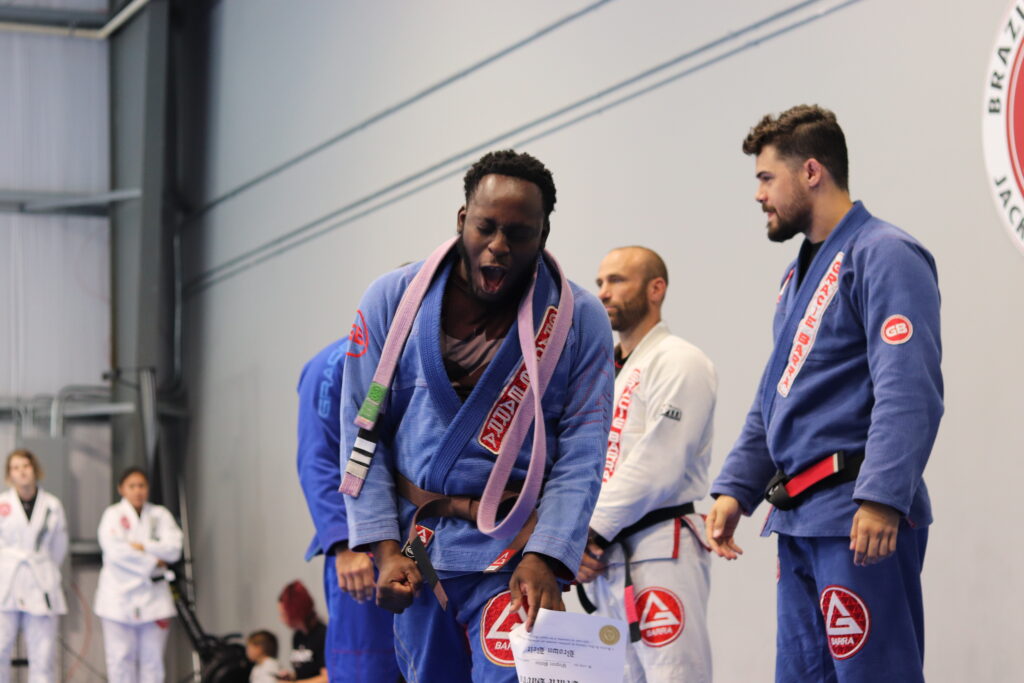Every martial art has its own belt ranking system, timeline, and requirements for moving up. The journey of a Brazilian jiu-jitsu (BJJ) student is no different, offering a finite path to advancement. It is common for new BJJ students to focus intently on this system, measuring their personal progress based on stripes and belt colors. After all, everyone likes to feel rewarded for their hard work.
However, most experienced jiu-jitsu practitioners will tell you the same thing: Belt rank is not nearly as important as you think.
How does the BJJ belt ranking system work?
Simply put, there are five main colors you will encounter at a BJJ gym (white, blue, purple, brown and black). Every new student begins as a white belt, regardless of their background in related sports or other martial arts. Traditionally, you may earn stripes as you progress based on various milestones. After you receive four stripes, you are presented with the next belt color.
Promotions (stripes and belts) are awarded based on a variety of factors by your instructor. First and foremost, you need to demonstrate that you are learning and practicing new skills and techniques. Also, they may consider your time spent on the mat, knowledge level, and performance in sparring and/or competitions.
For children, instructors may also consider attitude and behavior on the mat. If a child is disrespectful to instructors and other students, it can hurt their progress.
How important is BJJ belt rank?
While this belt system is set in stone, the truth is there is no objective way to accurately mark a student’s progress or their appropriate belt rank at a given time. Every BJJ student is writing their own unique story, and belt rank is only a minor detail in that story.
Ex-Navy SEAL commander Jocko Willink says there is often too much emphasis put on belt rank. “At some point, jiu-jitsu becomes a lot more than just belts. Eventually, the jiu-jitsu itself completely bypasses what the belts are and what the belts mean.” Jocko, who is now a Black Belt, said at one point in his training belt color became insignificant. “I just wanted to get better, I just wanted to know more, to keep training and I never even thought about it after that.”
For Jocko, wanting to keep learning should be the #1 priority of every BJJ student. “When you’re ready, your instructor is going to promote you. Until then, keep training.” This echoes the old jiu-jitsu adage, “A Black Belt is just a White Belt who never quit,” meaning that continuing to learn and grow matters more than advancing in belts.
Listen to Jocko explain his thoughts on the BJJ belt system on the Jocko podcast by clicking here.
Fellow Black Belt and vlogger Tyler Spangler agrees with Jocko, basing his reasoning on the varying skills of students. “There is no way you can evenly rank people in this sport,” said Tyler. “People that are just starting out with jiu-jitsu could either be a wrestler, gymnast, doing this as a hobby, or just trying to get in shape.” He went on to say a student with an extensive wrestling background could start tapping brown belts almost right away. And then there are new students who just want to get fit. But they are all technically beginner white belts.
How can this be? This is because each new student brings their own talents, skills, and strengths to their practice. One student may be young with a strong body, another may be middle-aged with excellent attention to detail, yet another may be small but agile. These three students can all thrive on their own path in Brazilian jiu-jitsu… so long as they keep training. As Michael Jordan once said, “I can accept failure; everyone fails at something. But I can’t accept not trying.” Keep training for you, not for the belt!
Aside from belts, there are plenty of other ways to feel rewarded and remain engaged in your BJJ practice! Check out this Gracie Barra article with tips to stay motivated.
Gracie Barra Jacksonville’s classes are designed for all skill levels for adults and kids starting from age 4 and up. Click here to schedule a trial class!

